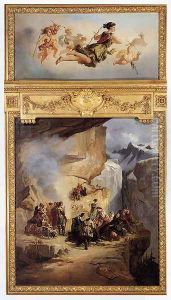Charles Diodore Rahoult Paintings
Charles Diodore Rahoult was a French painter born in 1826, whose work spans the 19th century, reflecting the Romantic and Orientalist styles that were prevalent during his time. Rahoult's art is characterized by its vivid portrayal of historical and mythological themes, often infused with a sense of drama and exoticism. Despite not being as widely recognized as some of his contemporaries, Rahoult's contributions to the art world during the 19th century were significant, showcasing a keen eye for detail and a profound understanding of color and composition.
Rahoult received his formal art education at the École des Beaux-Arts in Paris, where he was influenced by the teachings of prominent artists of the time. His early works were mostly historical paintings, but as he matured as an artist, he became increasingly fascinated with Orientalism – a trend among European artists that was sparked by Napoleon's campaigns in Egypt and the Near East. This fascination is evident in many of Rahoult's later works, which often depict scenes of Middle Eastern life with intricate detail and vibrant coloration, capturing the imagination of the European audience with their depiction of the 'exotic' world.
Throughout his career, Rahoult exhibited his works at the Paris Salon, the official art exhibition of the Académie des Beaux-Arts in Paris. His paintings were well-received, earning him recognition and accolades. Despite this success, Rahoult never achieved the level of fame of some of his contemporaries, such as Eugène Delacroix or Jean-Léon Gérôme, who are often more closely associated with the Orientalist movement. Nevertheless, his work provides a valuable insight into the 19th-century European fascination with the Orient and the Romantic spirit of the era.
Charles Diodore Rahoult passed away in 1904, leaving behind a legacy of art that continues to be appreciated by those who explore the depth of 19th-century European painting. His paintings can be found in various art museums and collections, serving as a testament to his skill and artistic vision. Rahoult's contribution to the Orientalist and Romantic movements remains an important part of art history, offering a window into the past and the ways in which the East was romanticized and depicted by Western artists during the 19th century.



